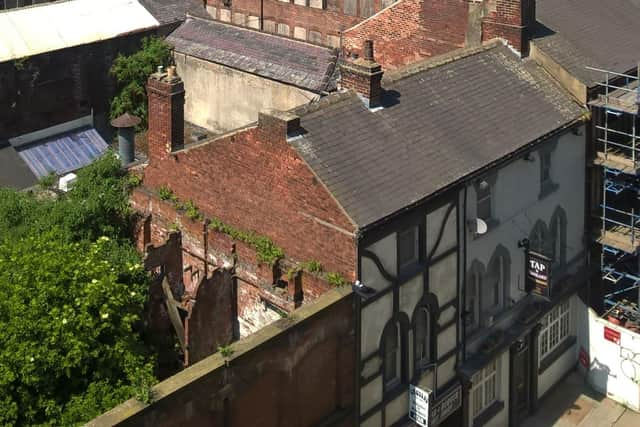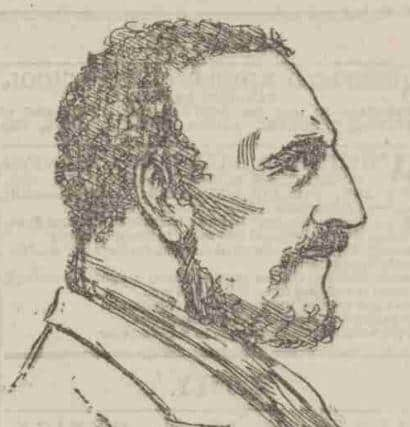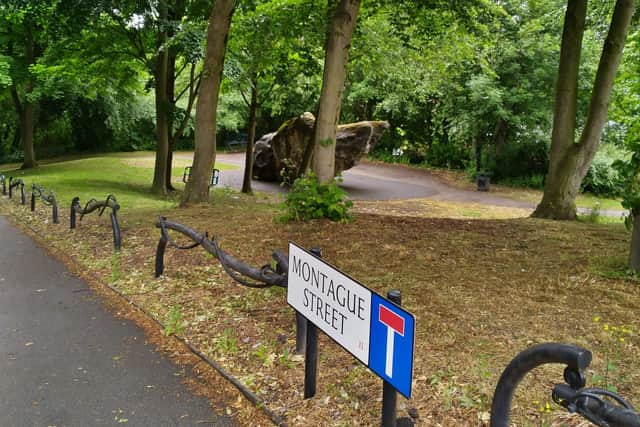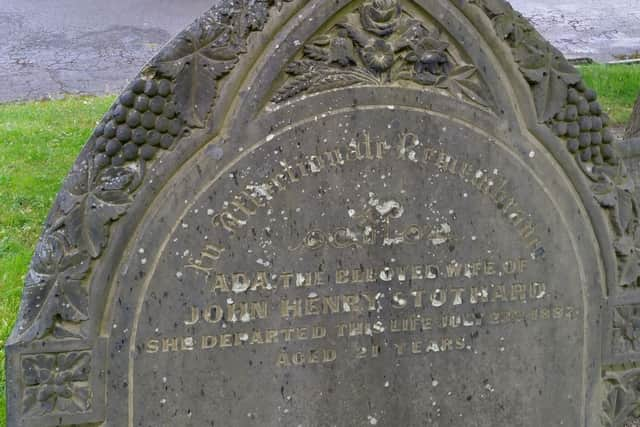The tragedy of Leah’s Yard in Sheffield – history of murder, deaths and misery
and live on Freeview channel 276
Before Leah arrived it was Cambridge Street Horn Works.
James Morton, haft and scale cutter, horn bone and ivory dealer, and drinking horn manufacturer, was there in 1849.
The street was then called Coalpit Lane, and was well known for being a centre for the trade in horn, bone,


ivory and other materials for knife handles.
Advertisement
Hide AdAdvertisement
Hide AdBy 1861 the works boasted a small steam engine, just enough to drive a few lathes and drills.
In 1863 Morton made significant changes, expanding into the rear yard and buildings of the adjacent Sportsman’s Inn, which was rebuilt at the same time.
After Morton died in 1870, the horn works were sold to Robert Thompson, although Morton’s brothers set up their own horn business across the street, also called, confusingly, Cambridge Street Horn Works.


The use of steam power increased, and Thompson decided to hire an ‘engine tenter’.
Advertisement
Hide AdAdvertisement
Hide AdSeveral works had such a man, who as well as looking after the engine acted as receptionist, janitor and general dogsbody.
In 1876 there arrived at the works a man who would have an unforgettable and permanent impact on those he served. That man was Henry Hobson.
Hobson was born in Huddersfield in 1839. His family moved to Sheffield when he was four, where his father opened a tobacconist’s shop in Arundel Street.


After working briefly as a grinder, he served four years with the 22nd (Cheshire) Regiment, then a further 10 with the 99th (Lanarkshire).
Advertisement
Hide AdAdvertisement
Hide AdHis conduct as a soldier was good but after discharge in 1868 he adapted poorly to civilian life.
His wife, Margaret, described their marriage in 1871 as a misfortune. Thompson seems to have tolerated his drunken, insubordinate ways, and so for a time did long-term employee John George Stothard and his son John Henry when they took over the works in 1883.
Finding him careless and neglectful, in August 1886 they gave him a month’s notice.


Hobson’s already volatile behaviour worsened. Decent enough when sober, when in drink he made vague threats to the Stothards, and was described as morose and vicious.
Advertisement
Hide AdAdvertisement
Hide AdThen on July 23, 1887, he went to the Stothards’ home at 99 Montague Street and attacked their maid, Florence, a girl of 13.
John Henry’s young wife Ada intervened, so Hobson turned on her and stabbed her to death. He was hanged for her murder one month later.
The Stothards had barely begun rebuilding their shattered lives when tragedy struck again.
Less than a month after Hobson met his end, John George was a passenger on a train near Hexthorpe, just outside Doncaster.
Advertisement
Hide AdAdvertisement
Hide AdIt was the time of the St Leger, and the town was busy with racegoers.
One train was stationary at a little platform while tickets were checked when an express ran into it at speed. Twenty-five passengers were killed.
Mr Stothard escaped with his life but he was severely injured and would remain bed-ridden at his home for the rest of his existence.
His wife, Sabina, was also an invalid, suffering chronic rheumatism and requiring almost constant care.
Advertisement
Hide AdAdvertisement
Hide AdIn October 1889 she was painfully negotiating the steep stairs alone at Montague Street when she fell.
When she was discovered she was found to have broken her neck and died instantly.
The careful provision that her husband had made in his will for her to receive a lifetime allowance of £2 per week would never be needed.
He lingered nine months more before finally succumbing to his injuries.
Even then, there was a sting in the tail.
Advertisement
Hide AdAdvertisement
Hide AdThe estate, including the Horn Works, was valued at £1,117, but after all debts were discharged there was only £73 left, about a year’s wages for a skilled worker.
The works were sold early in 1891. They were already home to several metal trades alongside the horn business, and these were now joined by Henry Leah.
John Henry, no longer a horn merchant but working alone as a journeyman horn cutter, was left as a single parent to his little son Herbert.
He had a scant few months to adapt to his new circumstances.
Advertisement
Hide AdAdvertisement
Hide AdIn November, Herbert contracted whooping cough. It turned to pneumonia, and after three days of struggling to breathe, he died. He was just four years old.
John Henry’s state of mind can only be imagined. In the space of four years, he had lost his young wife, both his parents, his livelihood, and finally his only child.
It is no surprise that, although little Herbert is recorded as buried in Burngreave Cemetery in the same grave as his murdered mother, only her name is carved on the stone.
Even if he could have afforded to pay the stonemason, his grieving father would have lacked the emotional strength to arrange it.
Advertisement
Hide AdAdvertisement
Hide AdEven after so many crushing blows, some people go on to build their lives anew. John Henry Stothard was not given the chance.
In June 1895 he was at his workshop in Mudford’s Terrace, at the corner of Shoreham and Mary Streets, when the fate that had stalked him for years delivered its final stroke.
Maybe he was a broken man who neglected his health, or he could not afford the medical treatment he needed, or perhaps nothing could have saved him.
Aged 32, he died of liver cancer.
His death certificate shows the mark of an informant who cannot write her name. It is Martha Bullas, his maternal grandmother, with whom he lived.
Advertisement
Hide AdAdvertisement
Hide AdAged 76, she had outlived her daughter, grandson and great grandson.
John Henry is also buried at Burngreave but his name was never added below his young wife’s.
With all his family gone save for his poor, widowed grandmother, there was no-one left able to do it for him.
*In February the city council, which bought the grade II-listed building in 2015 as part of its Heart of the City redevelopment plan, announced future plans for Leah’s Yard.
Advertisement
Hide AdAdvertisement
Hide AdThe idea is to incorporate the building into the second phase of the plan, maintaining its unique character and turning it into a new ‘maker’s space’ for creative sector workers.
The first step was to make the building structurally sound and secure.
Last year Philip Drury, who took over family firm F Drury Silvermiths Ltd in 1981, joined councillors and engineers to look around his old workplace.
Mr Drury started as an apprentice in his father Jack’s business in 1959 and worked at the site until it was sold to property developers in 2000.
At its height more than 100 people worked there.
Advertisement
Hide AdAdvertisement
Hide AdMr Drury said: “It’s very sad to see the state it’s in and how it’s deteriorated over the last 20 years.
“The work should have been done 20 years ago, it could have been superb.”
A message from the Editor:
Thank you for reading this story on our website. While I have your attention, I also have an important request to make of you.
With the coronavirus lockdown having a major impact on many of our advertisers - and consequently the revenue we receive - we are more reliant than ever on you taking out a digital subscription.
Advertisement
Hide AdAdvertisement
Hide AdSubscribe to The Star website and enjoy unlimited access to local news and information online and on our app. With a digital subscription, you can read more than 5 articles, see fewer ads, enjoy faster load times, and get access to exclusive newsletters and content.
Visit https://www.thestar.co.uk/subscriptions now to sign up.
Our journalism costs money and we rely on advertising, print and digital revenues to help to support them. By supporting us, we are able to support you in providing trusted, fact-checked content for this website.
Thank you
Nancy Fielder, editor